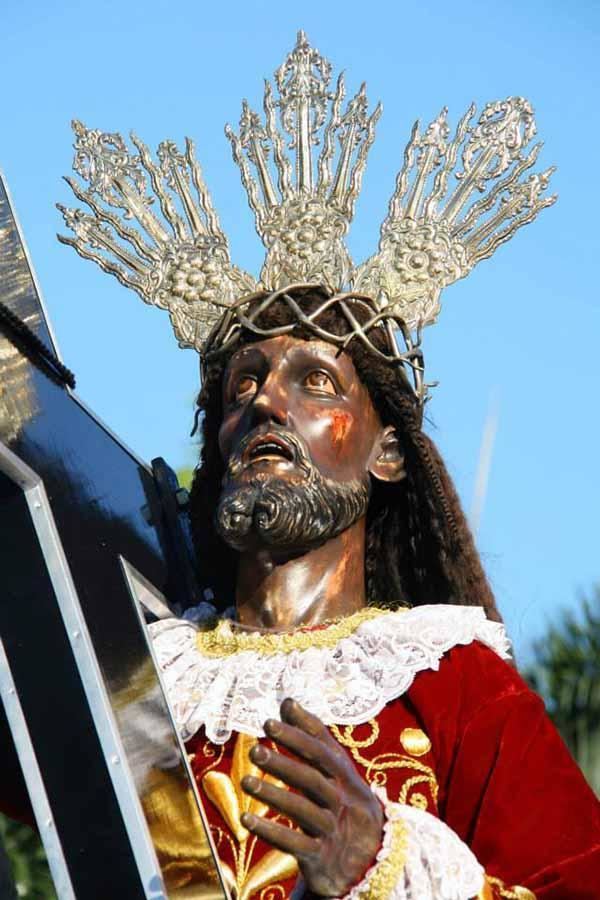 | ||
Witness Recollect PriestsBasílio Sancho de Santa Justa y Rufina, S.P., Archbishop of Manila Holy See approval Pope Innocent XPope Pius VII Similar | ||
Black nazarene leaves quirino grandstand
The Black Nazarene (Spanish: El Nazareno Negro, Nuestro Padre Jesús Nazareno, Filipino: Poóng Itím na Nazareno, Hesus Nazareno) is a life-sized image of a dark-skinned, kneeling Jesus Christ carrying the Cross enshrined in the Minor Basilica of the Black Nazarene in the Quiapo district of the City of Manila, Philippines.
Contents
- Black nazarene leaves quirino grandstand
- Nazareno 2017 scenes from the black nazarene procession
- Terminology
- ndas
- History
- Description
- Vestments
- Traslacin
- The Dungaw Rite
- Papal approval
- Devotions
- Hymn
- Outside Quiapo
- Idolatry controversy
- Transportation
- References
The Black Nazarene was carved from a dark wood in the 16th century in Mexico, and then transported to Philippines in 1606. It depicts Jesus en route to his crucifixion. Pope Innocent X granted recognition to the lay Confraternity of Santo Cristo Jesús Nazareno in 1650 for the promotion of the devotion to Jesus through the icon. It was housed in several churches near Manila in the early decades, arriving in Quiapo Church in 1787 where it has been enshrined ever since. The icon is renowned in the Philippines, and is considered by many Filipino Catholics to be miraculous, its mere touch able to cure disease. It attracts homage by numerous devotees and major processions every year.
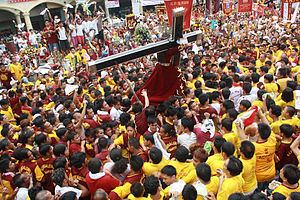
The image (in recent years a composite replica) is brought out of its shrine for public veneration three times a year: January 9, Good Friday (the Nazarene's "actual" feast, commemorating the culmination of the Passion), and December 31 (New Year's Eve, the first day of the novena). The January 9 procession reenacts the image's Traslación (literally, "transfer") in 1787, or "solemn transfer" to the Minor Basilica from its original shrine inside Intramuros. The January 9 Traslación is the largest procession, drawing millions of devotees thronging to touch the icon, and lasting 20 hours at the most.
The Black Nazarene is venerated by Filipino devotees every Friday, and along with the Santo Niño (Child Jesus) is the most popular object of devotion in the Philippines. A similar image called Cristo Negro is venerated in Portobelo, Panama.
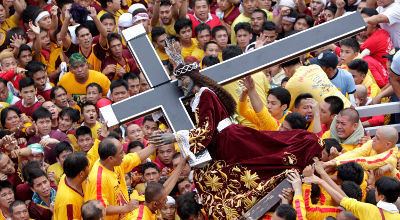
Nazareno 2017 scenes from the black nazarene procession
Terminology
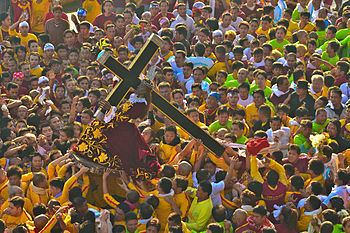
The image derives its name from "Nazarene", a title of Christ identifying him as a native of Nazareth in Galilee, and from its dark complexion – something uncommon amongst Philippine depictions of Jesus.
The Traslación procession is taken from the Spanish term for translation, referring to "passage" or "movement".
Ándas
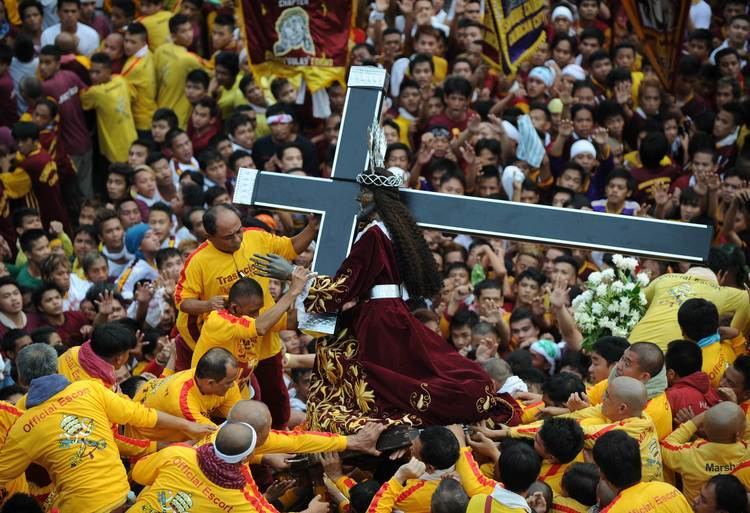
The image's wooden base is referred to as the peana, while its carriage or carroza used in processions is specifically called the Ándas (from the Spanish andar, "to move forward"). While the term andas is otherwise used for the shoulder-borne palanquins of religious images, the carriage retains the name as the Black Nazarene was processed on such a palanquin until the late 20th century.
History
The image was made by an anonymous Mexican sculptor, and the image arrived in Manila via galleon from Acapulco, Mexico, on May 31, 1606. Traditional accounts attribute the colour to votive candles burning before the image, although the most widespread belief is that it was charred by a fire on the galleon that brought it from Mexico.
Monsignor Sabino A. Vengco, Jr. from Loyola School of Theology meanwhile noted that the image was not charred but in fact dark through to its core, as it was carved from mesquite wood. Vengco based this claim on personal research in Mexico, where he said the wood was a popular medium in the period the image was carved. He also likened it to Our Lady of Antipolo, another popular image of similar provenance and appearance.
Originally, the image from Mexico (which belonged to the Recollects) was enshrined in the retablo mayor (high altar) of the Church of Saint Nicholas of Tolentino (also popularly known as "Recoletos Church", located a few distance away from modern-day Rizal Park) inside Intramuros. Both church and image perished during the bombardment and the flames of the Liberation of Manila in 1945.
A still-persistent common misconception is that the icon in Quiapo Church is the "lost" original image. On January 9, 1787, the Recollects donated a copy of the image to the Church of the Camisa (one of Quiapo Church's original names), which later on was celebrated by the faithful every January 9 by means of a procession (henceforth called the Traslación) from Intramuros (its original home, San Nicolas de Tolentino Church; later on outside Rizal Park) to Quiapo.
In contrast, the "lost" original image remained enshrined in the main altar, away from the crowds and only brought out during the Palm Sunday procession; the image enshrined in Quiapo, which have withstood almost 3 centuries of fires, earthquakes, and World War II, meanwhile was available for physical veneration by its devotees who time and again have attested to its miraculous powers.
The image presently enshrined above the main altar of Quiapo Church is actually a composite of the surviving copy's head and a replica sculpted by renowned Filipino santero (saint-maker) Gener Maglaqui, commissioned by the Archdiocese of Manila. The second composite comprises the surviving copy's body and the head of the Maglaqui replica. It is normally enshrined in a different part of the Minor Basilica and is the actual image used in the three major processions. This arrangement began in the 1990s because of security concerns and to prevent further damage to the icon; until then, the image donated in the 18th century as a whole was used in processions.
Description
The Black Nazarene's head wears a braided wig made of dyed abaca, along with a golden crown of thorns. Attached to the crown are the traditional "Tres Potencias" ("three powers") halo, symbolising the three powers of the Holy Trinity. These three rayos ("rays") are used exclusively for Christ in traditional Filipino and Hispanic iconography; it is an angular variant of the cruciform halo. The Quiapo image has lost several fingers over the years.
The barefoot image is shown in a genuflecting posture, symbolising the agony and the weight of the cross with the pain Christ endured during his Passion. The image bears a large, black cross of wood tipped with gilt brass caps.
Vestments
The image is dressed in a heavy velvet tunic of maroon, embroidered with floral or plant emblems in gold thread, and accented with lace collar and cuffs. Around the waist is a gold-plated metal belt embossed with the word "NAZARENO", while a golden chain and ball looped around the neck and held in its left hand represents the Scourging.
The image's vestments are changed in the Pabihis ("dressing") ceremony, which is held by a priest and devotees either inside the Minor Basilica or outside in Plaza Miranda. It is performed five times a year in preparation for major religious occasions, and is attended by the public.
Traslación
Every January 9, the Traslación of the Black Nazarene (commemorating the "solemn transfer" of the image's copy from San Nicolas de Tolentino in Intramuros to Quiapo) makes its way along the streets of Quiapo, with attendees reaching up to 12 million. In recent years a persistent misconception has the Traslación being repeatedly referred to (by the media as well as unscrupulous politicians) as mostly the "Feast of the Black Nazarene" (Pyesta ng Itim na Nazareno), and sometimes the "Feast of Quiapo" (Pyesta ng Quiapo), which (despite from the chaotic yet festive atmosphere) are far from correct: the Black Nazarene's "feast day" is the commemoration of Good Friday (which is one of the days when the image is processed); the diocese of Quiapo's actual feast day is June 24 (concurrent with Manila Day), the feast of the Nativity of St John the Baptist, who is Quiapo Church's actual patron (not the Black Nazarene).
In recent years, the processional route was altered due to a rise in accidents, to afford other neighbourhoods off the traditional route a chance to participate, and because of structural deficiencies in nearby bridges. It is normally only a school holiday for the schools near the processional route, but for the first time in the city's history, Mayor of Manila Joseph Estrada in 2014 declared the day a special non-working holiday due to the impassability of some thoroughfares and projected congestion in others.
As per custom, the Black Nazarene leaves the Minor Basilica a day or two before the annual procession, either in a public fashion or clandestinely. Since 2016, the procession begins at around 05:30 AM PST (GMT+8) after a solemn Midnight Mass at the Quirino Grandstand (usually presided by the Rector of the Minor Basilica but with the Archbishop of Manila preaching the sermon), followed hours later by Morning Prayer of the Liturgy of the Hours. It ends in Quiapo in late night of the same day or early the following morning, depending on how long the image has travelled. Some participants choose to wait for the image inside the Minor Basilica to greet it, while most devotees walk throughout the whole processional route. All devotees wear maroon and yellow like the image, and they walk barefoot as a form of penance and in emulation of Christ's walk to Golgotha. Authorities estimate that over 500,000 devotees strode barefoot in the 2013 procession, which was attended by 9 million people. Attendees include families of devotees, tourists, and members of devotees' associations throughout the country and overseas, all carrying their long estandartes (religious gonfalon) usually coloured maroon or white and embroidered in gold and emblazoned with the image and the association name.
The Black Nazarene is borne in procession on the Ándas, and traditionally only men were permitted to be namámasán ("bearers", devotees pulling the wheeled Ándas by its two large ropes). In recent years female namámasán have been allowed to participate. The custom of the Kanang Balikat, or placing the carriage's rope on the right shoulder, is thought to be of greater sanctity than placing it on the left, as it imitates the manner in which the image bears the cross.
Marshals from the Minor Basilica, known as the Hijos del Nazareno ("Sons of the Nazarene"), form an honour guard around the image, and are the only people permitted to ride with it on the Ándas for the duration of the Traslación. The Hijos – distinguishable from maroon-clad devotees by their yellow and white shirts – have the primary roles of protecting the icon from damage and directing the namámasán in front and behind through hand gestures, voice commands (sometimes using a megaphone), and whistle signals. In addition, they help devotees clamber up onto the Ándas to briefly touch the icon, and wipe the image with cloths tossed at them. The wiping of cloth on the image, which is also done during the Pahalík ("kissing") ritual during the vigil of the Traslación, follows the folk belief that cloth can be imbued with a holy object's miraculous powers (specifically its curative abilities). This transfer of sanctity through contact descends from the custom of ex brandea (cloth wiped on the bodies or tombs of the Twelve Apostles), itself part of the wider category of Third-class relics.
The Traslación is also notorious for the casualties that result from the jostling and congestion of the crowds pulling the Ándas. The injuries and even deaths of devotees are brought upon by one or a combination of heat, fatigue, or being trampled upon by other devotees. The 2012 Traslación is the longest in the image's recorded history as it ended after 22 hours, arriving at Plaza Miranda around 05:15 AM PST on the next day (January 10). The procession took longer than usual since the wheels of the Ándas broke early on at a point near Manila Hotel, and the rope broke near Liwasang Bonifacio. There were also reports of groups of devotees diverting the image from the previously decided route in order to pass by business establishments outside of the traditional route. This illicit act was done to allow homes and businesses off the planned route to receive the good luck and blessings of the image.
The Dungaw Rite
On January 9, 2014, the traditional Dungaw (a Tagalog calque of the rite's Spanish name Mirata, "to see" or "to view") was revived and reincorporated into the Traslación after the discovery of old documents attesting to its practise. The rite, which was discontinued in the early 1900s for still-unknown reasons, involves the Black Nazarene, coming from R. Hidalgo Street, being made to stop briefly at Plaza del Carmen, a square along the southwest flank of the neo-gothic Basilica Minore de San Sebastian, before proceeding towards Bilibid Viejo Street.
After the recitation of the rosary by the congregation inside San Sebastian, the resident Recollect priests remove the image of Our Lady of Mount Carmel from the retablo mayor. The image, which was given to the Recollects in 1617 by a Carmelite nunnery in Mexico City, is then processed to a specially-constructed, high platform at the southwest face of the church. There it is lifted up by several priests to "see" and "meet" the Black Nazarene as devotees fall silent and pray fervently. Shortly thereafter, the priests slowly turn the Virgin's image so that it "watches" the Black Nazarene and its procession depart the vicinity of Plaza del Carmen, after which it is returned to the high altar.
Theologically, the Dungaw rite reflects the fourth Traditional Station of the Cross, where Christ meets his mother, the Virgin Mary, en route to Golgotha.
Papal approval
Pope Innocent X approved veneration of the image in 1650 as a sacramental, and authorised the establishment of the Confraternity of the Most Holy Jesus Nazarene (Spanish: Cofradía de Nuestro Santo Jesús Nazareno).
For a majority of the Spanish Era, Filipinos were barred from taking Holy Orders, while confraternities were groups of religious laymen and thus an open option. Pope Pius VII gave the image his Apostolic Blessing in 1880, which granted plenary indulgence to those who piously pray before it.
Devotions
Religious veneration of the Black Nazarene is rooted among Filipinos who identify themselves with the passion and suffering of Christ which the image depicts. Many devotees of the Black Nazarene relate their poverty and daily struggles to the Passion of Christ as represented by the image.
While the actual patron saint of the Minor Basilica is Saint John the Baptist (and thus the actual parochial diocesal feast day being 24 June, concurrent with Manila Day), the Black Nazarene and its Traslación are more popular. At the end of each Mass offered in the Minor Basilica, devotees pay homage to the image by clapping their hands. In addition to the novena, Traslación, Pahalík, and the Pabihis, the Pasindi ("lighting") or lighting of votive candles is another popular devotion, as is the decades-old devotion of traversing on knees the length of the nave of Quiapo Church towards the main altar enshrining the image.
The Friday of each week in the year (except Good Friday, the actual "feast day" of the Nazareno in general) is colloquially known in Metro Manila as "Quiapo Day", since the novena in the image's honour is held on this day nationwide. As with Wednesday (which is comparably called "Baclaran Day"), this day is associated with heavy traffic surrounding the vicinity due to the influx of devotees.
The Nazarene Catholic School (formerly known as the Quiapo Parochial School) reflects the devotion of decision-makers of the school to the Black Nazarene. The school's official newsletter is likewise named "The Nazarene" with the pupils attributed as being "Nazareneans."
The largest procession in reverence for the Black Nazarene idol is the January 9 Traslación procession every year, attracting millions of Catholic devotees, who throng to touch or get their towel touched by the image carriers and the image and thereby get a blessing from the image. Beyond the procession, every Friday, the image of the Black Nazarene is venerated by Filipino devotees. It is, along with Santo Niño (Child Jesus), is the most popular object of devotion in the Philippines. In 2011, over six million Catholic devotees flocked to the Black Nazarene procession.
Hymn
The hymn Nuestro Padre Jesús Nazareno was composed by Lucio San Pedro to honour the image. It is used by the Minor Basilica as the official anthem of the devotion and its associated rites.
Waray Waray lyricsOutside Quiapo
Similar processions replicating the Traslación are also held on 9 January in other parts of the country. The largest of these is held in Cagayan de Oro City, which uses an official replica of the image given by the Minor Basilica in 2009.
Filipinos overseas have brought the tradition of a procession and Mass honouring of the Black Nazarene image to countries such as Australia and the United States. As in Quiapo, a copy of the image is paraded through the streets or within the parish bounds, with devotees reciting prayers in its wake.
In September 2012, a replica of the Black Nazarene was canonically enshrined at Saint Catherine of Siena Roman Catholic Parish in Reseda, California, United States.
On March 4, 2014, a replica of the Black Nazarene from Quiapo Church arrived at the Old Chapel of St. Rock the Healer Mission Center, Bishop's Compound, Brgy. Cawayan, Catarman, Northern Samar. Since then, many devotees across Northern Samar came to venerate the sacred image, especially during Fridays. At that time, the said mission center were constructing a bigger church.
On January 9, 2015, the first Traslación was held, in solidarity with the Quiapo Church. It was when the sacred image was transferred from the old church to the new and unfinished church building. Crowds not only from Northern Samar but all over the island attended.
On September 12, 2016, the newly constructed church was blessed, dedicated and consecrated by His Eminence Luis Antonio Cardinal Tagle. The event was concelebrated by the priests from Quiapo Church, Felomino G. Bactol (Bishop of Naval), Bishop Emeritus Anghel Hobayan (the first bishop of the Diocese of Catarman), Bishop Emmanuel C. Trance (present Bishop of Catarman), Mission Center's first administrator Rev. Fr. Alan Abalon and Mission Center's second administrator and rector Rev. Fr. Rico M. Manook. The event was attended by many religious people from different dioceses in Eastern Visayas. Also, during this event, the St. Rock the Healer Mission Center was elevated as the Diocesan Shrine of Nuestro Padre Jesus Nazareno, making it the first church in the Visayas to be declared a shrine in honor of this image.
Idolatry controversy
According to Jaime Laya, the devotional worship of Black Nazarene of Quiapo is idolatry, but he states it may be a continuation of possibly pre-Christian local ritual practices. Elizabeth Pisares also states that this is idolatry, and suggests its link with the social disparities among the Filipino. In contrast, according to the rector Monsignor of Quiapo, Jose Clemente Ignacio, the procession and devotion is not idolatry, rather it is a reflection of "Filipino trait to want to wipe, touch, kiss, or embrace sacred objects if possible", and it is just a belief in "the presence of the Divine in sacred objects and places". According to Mariano Barbato, the debate over the icon is centred on the questions of what constitutes idolatry, when an icon becomes a false god, and what makes the procession ritual idolatrous.
Transportation
Travel within the City of Manila during the Traslación every January 9 might be difficult as heavy traffic is expected. Most jeepneys use alternate routes for the day to avoid the procession, thus creating additional travel time. Some public transport systems such as the LRT-1, LRT-2, and MRT-3 provide free rides to devotees, who are easily identifiable as dressed in maroon and walking barefoot.
Traffic rerouting is implemented on the annual procession and the day before, and is enforced by the Manila Police District with reinforcements from the Philippine National Police and, since 2014, the Armed Forces of the Philippines and the Metropolitan Manila Development Authority. The Philippine Coast Guard guards stretches of the Pasig River along the Jones (since 2014), Quezon and MacArthur (until 2014) bridges to ensure the safe passage of the procession.
A similar scenario may be experienced by tourists and travellers in Cagayan de Oro and in Catarman, Northern Samar during the yearly processions of the sacred image, as well as in other towns and cities where replica images are brought out in procession on this day.
